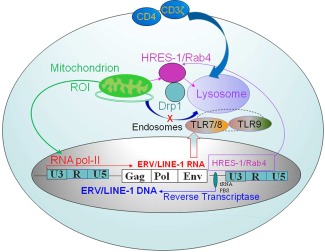Figure 1.

Mechanistic diagram of endogenous retrovirus (ERV)–regulated endosomal recycling in autoimmune diseases. ERVs and other retroelements are integrated into the nuclear DNA. ERVs are transcribed into RNA by RNA polymerase II (RNA pol II). In turn, retroviral transcripts can be reverse transcribed into DNA using transfer RNA (tRNA) as a primer. While most ERVs are transcriptionally silent, as a rare example, human T lymphotropic virus–related endogenous sequence 1 (HRES‐1) is transcribed into RNA and translated into protein, such as HRES‐1/Rab4 (4). This small GTPase promotes the recycling and lysosomal degradation of cell surface receptors, such as CD4 (4), CD3ζ 5, and Drp1 (6). The HRES‐1/Rab4–mediated depletion of dynamin‐related protein 1 (Drp1) inhibits mitochondrial fission and causes the accumulation of mitochondria that results in increased production of reactive oxygen intermediates (ROIs) in lupus T cells 6. Thus, the accumulation of mitochondria may underlie oxidative stress in patients with systemic lupus erythematosus 8. TLR‐7 = Toll‐like receptor 7; LINE‐1 = long interspersed nuclear element 1; PBS = primer binding site.
